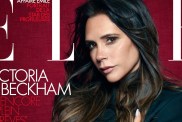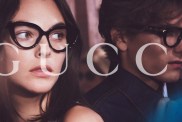

Mark Abrahams with his portrait of Eva Herzigova
Mark Abrahams is one of the most REAL photographers of our time; his images are so authentic and present and show you an intense depth into the soul of the subjects that he shoots. His engaging and mesmerizing portraits always leave you wondering and you always want to know more. You feel as though you are in the room or you can look into the eyes of the subject. One of my favorite portraits that Mark ever shot was of Dennis Hopper (below).

I had the honor of attending the opening of the exhibit on December 14 at Annie Leibovitz’s Studio. Before interviewing the photographer, I spoke with Annie Leibovitz about the exhibit:
Cannon: Mark’s exhibit is here at your studio; tell us about Mark’s work?
Annie Leibovitz: Mark’s portraits are very clear and simple. It makes celebrities into people. I see the people. The portraits are direct. Mark has never been into big productions; his photos are direct into the eyes of the subject.
We are old friends; our children went to school together. I know his work very well.
C: Talk about the art of Mark’s photography?
AL: Mark’ s photos are strong yet simple. I told him to make a volume of his work and I am so proud that he did. We both want to be modest, but proud of our work. I’m afraid to be straight on with people, something which Mark is so good at.

I also spoke briefly with Grace Coddington:
Cannon: Tell us about Mark’s work.
Grace Coddington: I have known Mark for many years. It’s great to see all of his work in one place. It’s really special.
Finally, I spoke with the guest of honor, himself:
Cannon: What inspires your images?
Mark Abrahams: I’m inspired by simple, pared down images that don’t rely on gimmicks or frivolous styling or overly produced concepts. It’s true, most of my subjects happen to be quite recognizable, but that is of little importance to me. I’m usually inspired by the moment, so I don’t do research or prep extensively for photo shoots. When I meet a subject on set, I try to discover and break through to who they are slowly and carefully, allowing them to reveal aspects of their character they might not anticipate sharing with a stranger. I find that subjects usually are promoting a film or have expectations when they come into a photo shoot and I try to deconstruct those expectations with my camera to create images that are raw, honest and direct. I isolate and capture the individual subjects as they perceive themselves to be in that moment rather than trying to recreate them as a super hero or in the spirit of their latest film. I try to strip away the veneer and dig a little bit deeper into people than they might expect, but usually with quite honest results.
continued…
C: Annie has said your portraits are psychological portraits?
MA: I hear that a lot, and photo shoots can sometimes bring people’s psychological nuances to the surface. My camera will usually capture those subtle insights. If there is any psychology that comes through, it is in the dynamic between my subject and me and the outcome of the portrait sitting is always unknown—you don’t really know what you are going to get when a subject comes into the studio. So much about an honestly good portrait depends on the psychology of the sitter and how comfortable they are in their own skin, or in transforming themselves for the camera. Most actors are quite used to having a lot going on and having a director and a script, with sets, storyboards and a defined sense of place. I break that down and allow everyone to be themselves.
C: Annie said she’s afraid to be so straight on with people; but says that is what you are so good at?
MA: That’s really flattering. Like Annie, I grew up on military bases with a real sense of being honest, direct, and to the point with people. In truth, I’m painfully shy and a camera was always the easiest way for me to converse and look at people without feeling uncomfortable. After twenty years, it’s become really easy for me to walk onto a busy set and everybody is doing something to execute a prearranged image, but it’s more rewarding on a personal level to enjoy the intimate and personal dynamic that occurs between a photographer and sitter, one on one from virtually nothing. Annie has also done some really amazing close up portraits I admire of Bob Dylan, Willie Nelson, I can go on and on…

C: The image of Christina Ricci followed me through the room, and I saw this was one of your largest images. Tell us about this shoot?
MA: She has the most captivating eyes and I wanted to capture that aspect of her face. It’s almost like being watched by a beautiful owl, if that makes any sense, because there is an extraordinary depth and integrity that lies beneath the surface. It’s virtually impossible not to be drawn in by her gaze, on set or in a gallery image.
C: Your image of Joaquin Phoenix is hauntingly amazing; tell us about this shoot?

MA: He’s probably one of my favorite subjects on so many levels because he engages and actively participates in the experience. Joaquin isn’t going to stand vacantly in front of the camera waiting for something to happen, opting instead to push and challenge the situation in a collaborative relationship. The image in the book depicts Joaquin flying full force into a concrete wall and that was the first frame I shot after he fell to the ground. The composition almost looks likes he’s in the womb.
continued…

MA: WOW, that’s probably true. I really approach every subject from the same stance, regardless of their perceived accomplishments or celebrity status, because I view everyone as being equal to me. I can intuitively read people really well, so usually I allow them to open up to me slowly and comfortably at their own pace and really don’t focus on their prior accomplishments. I don’t try to transform people into other characters, like making Joaquin into Johnny Cash, I would rather know who they think they are when they are alone. Contemporary photography does celebrate the celebrity, and that’s great, but I want to show the side of their character that you don’t always see.
I’d rather get into a little bit about the psychology of their life — I ‘m not interested into making everyone into a hero. Within the luxury brand magazine culture, there is the very real pressure of commerce that makes celebrity shoots into branding tools to sell something. I do both every week, but it is nice to occasionally celebrate people as individuals.
C: I love that and it is so true. Too often do we idolize celebrities and make them more than people.
MA: That was the point of this book.
C: I Loved all printing at the exhibit, it was so crisp and sharp.
MA: I loved the Avedon show at the Whitney, especially the large scale of the images. Initially I was going to do small prints but when I saw this space, I just had to scale everything big.
C: There is a real grittiness and personality to your imagery; how do you get so personal with the celebrities who are often so afraid to let anyone in? Everyone is always so present in your imagery as well, it’s extremely refreshing. Tell us about your style of shooting? And how you approach the subject.
MA: I do not do a lot of small talk before a subject comes on camera. I start the dialogue when they are on set and we just talk and try to find things they are interested in and find a way to push through the dialogue. Relationships have to be organic and natural to mean anything or have any semblance of value.
C: Do you close the set?
MA: I don’t but try to keep the connection as private as possible.
C: When did you first pick up a camera?
MA: I didn’t set out to become a photographer and never had the luxury of attending a fancy photography school or assisting an established photographer. I started taking pictures between my shift’s working for a trucking company in Southern California and captured images of the old truckers on break at the sand and gravel pits playing checkers, leaning against old sheds or changing a tire. A friend owned a coffee shop in Costa Mesa and agreed to hang my photographs in a mini exhibit. A woman from Warner Music saw the images and hired me to shoot musicians and album covers. At that time I didn’t know that photography was even a career option. Sometimes I’d hock my camera at a pawn shop on La Cienega, ask for a cash advance, and get my camera out of hock whenever I got a photography gig. I remember showing up on the set to Madonna’s video for “Express Yourself” and I couldn’t believe I was being paid for the experience. Whatever collision of events brought photography into my life, it’s made the experience of my life incredibly rewarding.
C: Advice to the youth in photography?
MA: Someone gave me this advice. If you lead an interesting life, you can take interesting pictures.
C: That is the best advice that I have ever heard.
Mark’s photo book is available for purchase at amazon.com.





